You know what’s wild? Nearly 9 out of 10 Americans are planning to celebrate Thanksgiving this year, according to Statista, making it one of the most universally observed holidays in the country. I remember sitting around our family table last year, watching my grandmother’s eyes light up as she shared the same story about her first Thanksgiving in America – for probably the twentieth time. Yet somehow, that familiar tale still brought tears to my eyes and reminded me why these thanksgiving stories matter so much.
Whether you’re looking for heartwarming tales to share during dinner, educational stories for the classroom, or simply want to discover narratives that capture the true spirit of gratitude, the right story can transform an ordinary gathering into an unforgettable experience. I’ve been obsessed with finding stories that go way beyond the usual turkey-and-Pilgrims stuff, and I’m excited to share what I’ve discovered.

Table of Contents
-
So What Makes a Thanksgiving Story Actually Worth Reading Out Loud?
-
25 Top Thanksgiving Stories Across 6 Categories
-
Traditional Family Stories (Stories 1-5)
-
Cultural and Historical Perspectives (Stories 6-9)
-
Heartwarming Community Stories (Stories 10-13)
-
Personal Growth and Reflection Stories (Stories 14-17)
-
Inspirational and Spiritual Stories (Stories 18-21)
-
Contemporary and Humorous Stories (Stories 22-25)
-
-
How to Pick Stories That Actually Work for Your Family
-
Want to Write Your Own? Here’s How AI Can Help
TL;DR
-
Choose thanksgiving stories based on who’s actually going to be listening, whether you want them laughing or crying, and how much time you’ve got
-
The 25 featured stories span six categories from traditional family tales to contemporary humor, so there’s something for every type of celebration
-
Stories like “The Empty Chair” and “Two Tables” show how good narratives can make people actually put their phones down and pay attention
-
My evaluation tips help you pick stories that won’t bomb at your dinner table
-
AI story generators can help you create personalized thanksgiving stories that include your family’s weird traditions (we all have them)
So What Makes a Thanksgiving Story Actually Worth Reading Out Loud?
Look, picking the perfect thanksgiving story is kind of like picking the right wine for dinner – you need to know your crowd. Are there little kids who’ll get bored after two minutes? Teenagers who’ll roll their eyes at anything too sentimental? That one relative who makes everything political? Understanding what works for your specific group means the difference between a meaningful moment and everyone checking their phones.
Here’s the thing about audience appropriateness – it’s not just about age ranges, though that matters. You need to consider who will be reading or hearing these thanksgiving stories and what they can actually handle. Family gatherings require different content than classroom settings, and what works for your book club might flop with your in-laws.
When crafting stories for younger audiences, consider using a kids story generator to ensure age-appropriate content and themes.
|
Story Selection Reality Check |
Family Gatherings |
Educational Settings |
Community Events |
|---|---|---|---|
|
Age Range |
Everyone from 5 to 85 |
Grade-specific groups |
Mostly adults |
|
Attention Span |
5-10 minutes max |
15-20 minutes if engaging |
10-15 minutes sweet spot |
|
Complexity |
Keep it simple |
Educational but not preachy |
Culturally aware |
|
Sensitivity Level |
Inclusive without being boring |
Historically accurate |
Diverse perspectives |
|
Emotional Tone |
Heartwarming wins |
Thought-provoking works |
Inspiring but not cheesy |
Stories that actually mean something separate the memorable ones from the forgettable fluff. The most powerful thanksgiving narratives dig into complex themes like family drama, personal growth, forgiveness, cultural identity, and what abundance really means. These stories stick with people long after the leftovers are gone.
Length matters more than you think. Do you need short thanksgiving stories for quick sharing while people are still hungry? Medium-length pieces for after dinner when Uncle Bob is too full to interrupt? Or longer narratives for people to read quietly while doing dishes? The format also matters – some stories work better when read aloud, while others shine when people can read them privately.
My friend Sarah’s family does this thing where they read one story during appetizers (because everyone’s still hungry and paying attention), another after dinner (when Uncle Bob is too full to argue), and then leave a longer one out for anyone who wants to read it later while doing dishes. This approach keeps everyone engaged without making it feel like homework.
Making sure you’re not accidentally being offensive has become essential for modern thanksgiving stories. The best narratives acknowledge different perspectives and avoid perpetuating harmful stereotypes. Look for stories that represent various cultural backgrounds and interpretations of gratitude without feeling forced or tokenistic.
Will this make people feel something real? varies based on what you’re going for. Sometimes you want stories that inspire deep reflection, other times you need narratives that provoke laughter or happy tears. The most effective thanksgiving stories often combine multiple emotions to create a rich experience that people actually remember.
Does this actually work for what you need it for? determines whether a story serves your specific situation. Consider whether you’ll use these stories for family traditions, educational purposes, community events, or just personal enjoyment. This influences the style, complexity, and message that will actually work in real life.
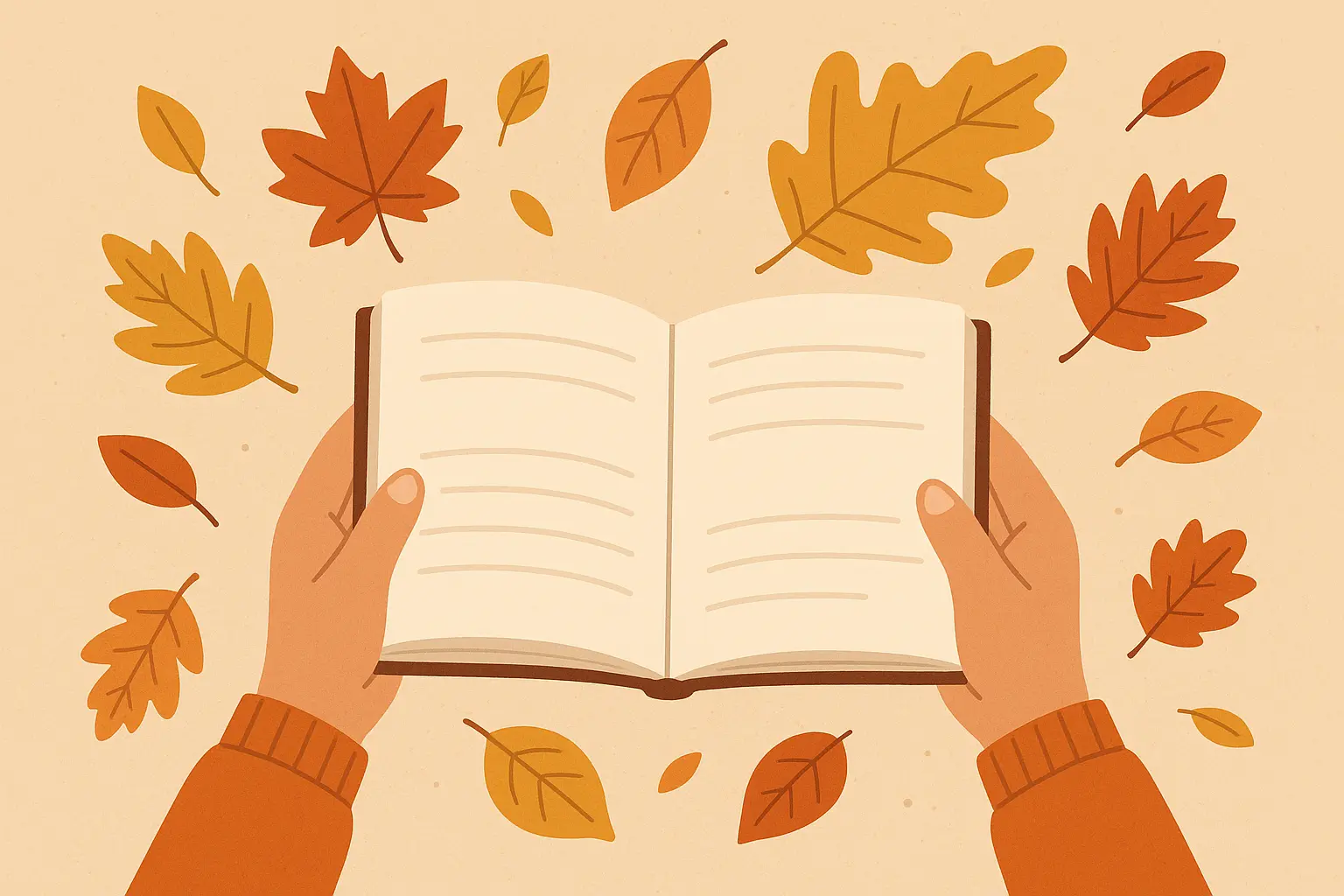
25 Top Thanksgiving Stories Across 6 Categories
Okay, here’s where we get into the good stuff. I’ve organized 25 carefully selected thanksgiving stories into six categories that actually make sense for how people celebrate. From traditional family stories that’ll make your grandma happy to contemporary tales that address modern chaos, these thanksgiving stories cover the full range of thanksgiving experiences. Each story includes honest descriptions of what you’re getting into, so you can pick the ones that won’t bomb with your particular crowd.
Traditional Family Stories
1. “The Empty Chair” by Rebecca Martinez
Okay, this one gets me every time. There’s this family who always sets an extra place at dinner for people they’ve lost, right? But then this lonely neighbor shows up, and suddenly that empty chair isn’t so empty anymore. I’m not crying, you’re crying.
The story follows a family’s tradition that takes an unexpected turn when someone living needs that chair more than their departed loved ones do. It’s beautiful because it shows how grief can coexist with gratitude, and how family traditions can evolve to embrace new members while still honoring the past. Fair warning: keep tissues handy.
2. “Grandmother’s Recipe Box” by Thomas Chen
This one hits different if you’ve ever fought with siblings over family stuff after someone passes. These adult kids are arguing over their grandmother’s recipe collection – everyone wants different dishes – until they realize the recipes are meaningless without the stories and love that came with them.
The story unfolds through flashbacks and present-day arguments, showing how their grandmother used cooking to pass down family history. The resolution comes when they figure out that the real inheritance wasn’t the recipes themselves, but the memories and traditions that made them special.
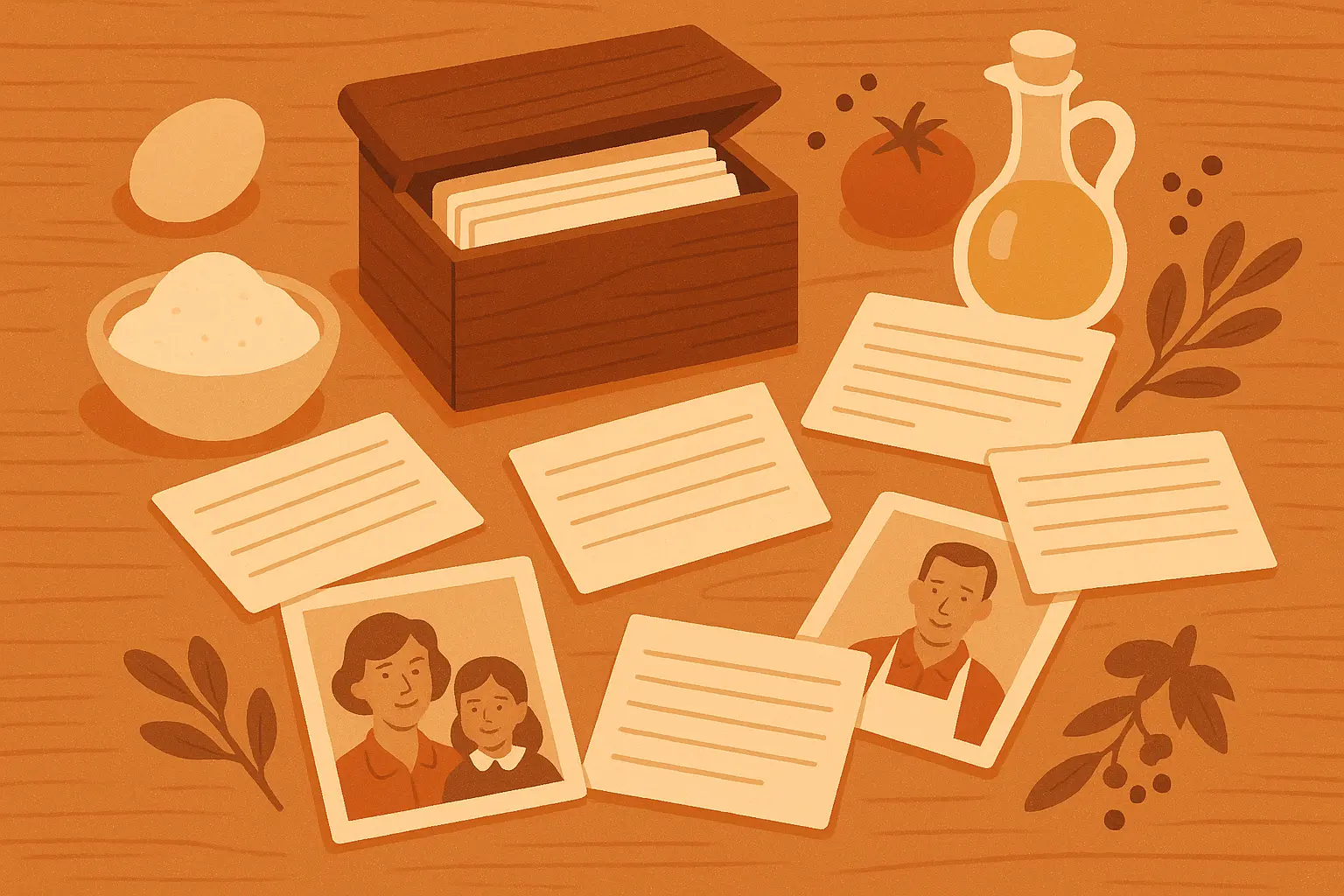
3. “The Traveling Turkey” by Sarah Johnson
Here’s a story that tackles modern family reality with humor and heart. A divorced couple creates this innovative tradition where the thanksgiving turkey literally “travels” between their two houses, so their kids get to celebrate with both parents. It’s creative problem-solving that actually works.
The story follows their first thanksgiving after divorce, where both parents are trying to maintain traditions for their children. Their solution becomes a symbol of how families can adapt while keeping what matters most. It balances the real challenges of co-parenting with the joy of creating new traditions that work for everyone.
4. “Thanksgiving Confessions” by Michael Rivera
This one’s intense but in a good way. During one family dinner, three generations start sharing secrets they’ve kept for years. It transforms their understanding of each other through radical honesty, and it all happens through dinner conversation.
The story takes place entirely during one thanksgiving meal, where a simple question about gratitude leads to increasingly personal revelations. Each family member shares something they’ve never told the others – from embarrassing moments to life-changing decisions. It shows how vulnerability can actually bring families closer together.
5. “The Potluck Miracle” by Linda Williams
Disaster strikes when a kitchen fire ruins this family’s traditional thanksgiving dinner, but neighbors from all different cultural backgrounds show up with their own dishes. What could have been a ruined holiday becomes this beautiful fusion celebration that’s better than anything they’d planned.
The story starts with catastrophe but turns into something magical when the community rallies. The resulting meal becomes more meaningful than any traditional thanksgiving dinner, teaching the family that diversity can enhance rather than diminish holiday celebrations. It’s a great reminder that sometimes the best moments come from the worst disasters.
Cultural and Historical Perspectives
6. “Two Tables” by David Crow Feather
This story is heavy but so important. It’s about a Native American family trying to figure out how to do Thanksgiving when the whole holiday is… complicated for them. It presents dual perspectives that acknowledge both gratitude for family and the painful realities of historical trauma.
The narrative alternates between two thanksgiving celebrations – one at a Native American family’s home and one at their white neighbors’. The teenage protagonist struggles with participating in school thanksgiving activities while maintaining her cultural identity and historical awareness. It’s not an easy read, but it’ll make you think about perspectives you might never have considered.
My friend Lisa uses “Two Tables” as part of her family’s educational thanksgiving tradition. Before dinner, they spend 20 minutes discussing the story’s themes, letting their teenagers ask questions about historical perspectives they hadn’t considered. She says it’s led to some of the deepest family conversations they’ve ever had about privilege, history, and understanding multiple viewpoints.
7. “First Thanksgiving in America” by Maria Santos
This one follows a recently immigrated family experiencing their first American thanksgiving while missing harvest celebrations from their homeland. They’re trying to figure out these unfamiliar traditions while preserving their cultural identity, and it’s both heartwarming and relatable.
The family navigates turkey and cranberry sauce while missing their homeland’s harvest celebrations. Through their preparation and celebration, they discover ways to incorporate elements from both cultures, creating a unique thanksgiving that reflects their journey. It emphasizes how immigration enriches rather than diminishes cultural traditions.
8. “The Mayflower’s Other Passengers” by James Historical
Finally, someone wrote about the people who weren’t Pilgrim leaders. This historical account focuses on the indentured servants and working-class passengers – the folks who made up most of the Mayflower but never make it into elementary school plays.
Instead of the familiar Pilgrim leaders, this story follows servants, craftsmen, and laborers who had very different experiences. Their perspective reveals the harsh realities of survival and complex social dynamics that shaped early colonial life. It’s a more complete picture of what actually happened.
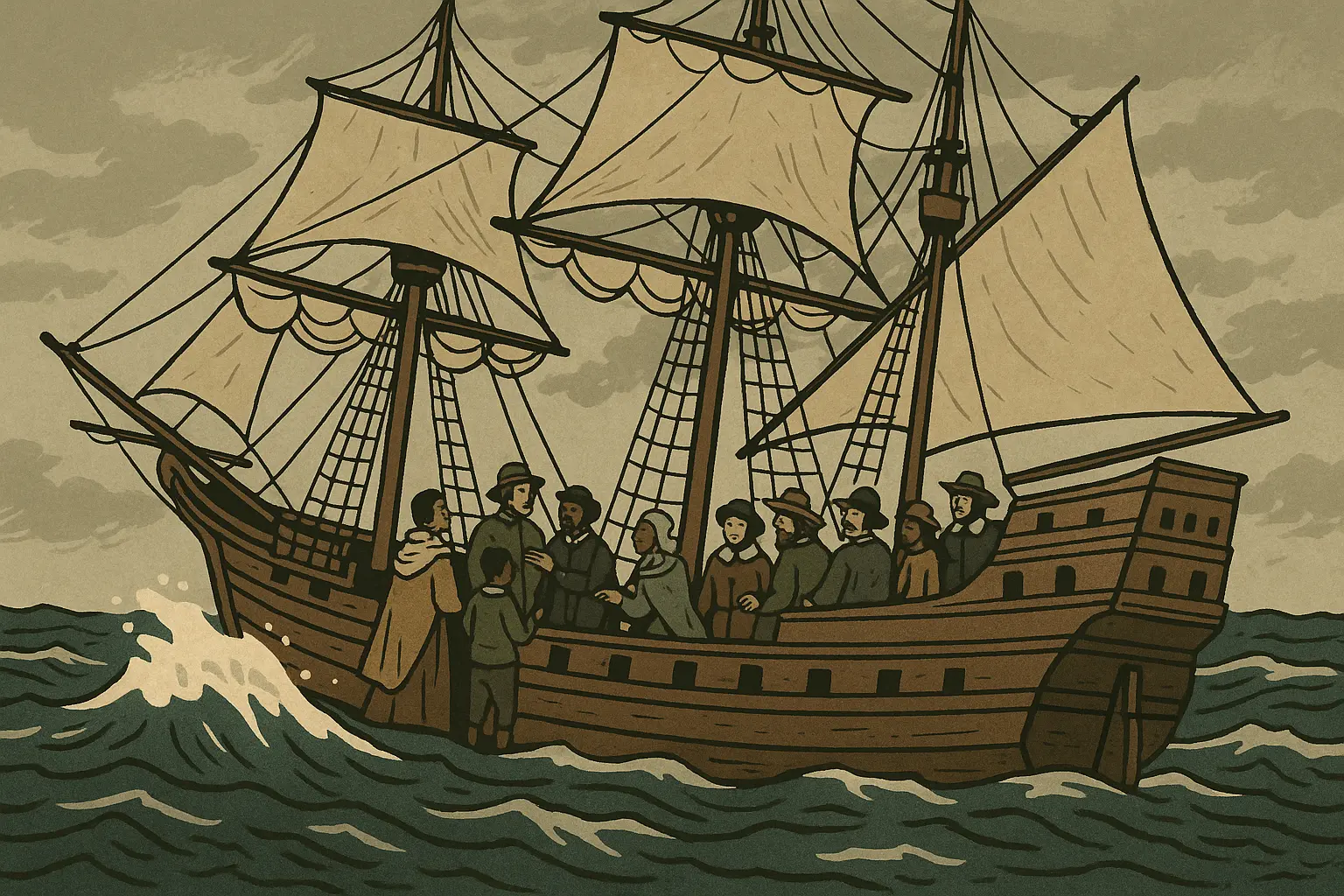
9. “Thanksgiving in Chinatown” by Amy Liu
A Chinese-American family figures out how to blend thanksgiving with elements from the Mid-Autumn Festival, creating something uniquely their own. It’s a perfect example of how cultural fusion can create richer, more meaningful holiday experiences.
The family initially feels caught between two cultures until they realize they can create their own traditions that honor both. By incorporating moon cakes, family stories, and gratitude practices from both cultures, they develop a thanksgiving celebration that truly reflects who they are.
Heartwarming Community Stories
10. “The Soup Kitchen Angel” by Patricia Moore
Plot twist alert: A wealthy woman volunteering at a soup kitchen discovers that one of the guests is her former high school teacher who inspired her success. This story challenges every assumption you might have about success, failure, and who deserves what in life.
The story follows a successful businesswoman’s volunteer work, which she initially approaches with some condescension. When she recognizes her high school English teacher among the guests, everything changes. It explores economic vulnerability, human dignity, and how giving and receiving help is more circular than we think.
11. “Thanksgiving at the Fire Station” by Captain Rodriguez
These firefighters are trying to have thanksgiving dinner together, but they keep getting called away for emergencies. Each interruption initially frustrates them, but they gradually realize their service is its own form of thanksgiving. It’s a beautiful tribute to people who serve their communities during holidays.
The firefighters’ attempts to celebrate keep getting interrupted, but instead of ruining their day, the calls remind them why their work matters. The story shows how duty and gratitude can intertwine, and how chosen family can be as meaningful as biological family.

12. “The Apartment Building Feast” by Jennifer Park
When the heat fails in this apartment building on thanksgiving day, residents who barely knew each other end up sharing food and stories in the lobby. What starts as a crisis becomes this amazing community celebration that transforms how they see their neighbors.
The story begins with isolated residents planning solitary celebrations. When the heating system fails, they’re forced into the communal space where one elderly resident suggests sharing resources. The resulting potluck becomes a revelation about community and the family we can create with the people who live around us.
13. “The Food Bank Thanksgiving” by Robert Green
This story takes place during a food bank’s thanksgiving distribution, where conversations between volunteers and clients reveal that the line between helper and helped is thinner than anyone expects. It challenges stereotypes about poverty and charity without being preachy.
The narrative unfolds through these interactions that show how anyone can experience hardship, and how true charity involves recognizing everyone’s dignity and worth. It’s eye-opening without making you feel guilty about your own circumstances.
Personal Growth and Reflection Stories
14. “The Gratitude Journal” by Michelle Adams
A cynical teenager gets forced to keep a gratitude journal and discovers unexpected sources of thankfulness in her seemingly difficult life. The transformation feels authentic because it acknowledges real problems while finding legitimate reasons for appreciation – no toxic positivity here.
The story follows this reluctant teenager through her journal assignment, starting with sarcastic entries that gradually become more genuine as she notices small positive moments. The change feels real because it doesn’t pretend her problems disappear, just that she finds ways to appreciate what’s actually good.
15. “Thanksgiving After Divorce” by Karen Mitchell
A newly single mother faces her first independent thanksgiving and discovers inner strength she didn’t know she had. This story offers hope and practical wisdom for anyone navigating major life changes during the holidays – and let’s be honest, that’s a lot of us.
Karen’s first thanksgiving as a divorced mom starts overwhelming, but through a series of small disasters and unexpected moments of joy, she learns that imperfect celebrations can be more authentic than picture-perfect ones. It’s about resilience and the power of adaptation when life doesn’t go according to plan.
16. “The Prodigal’s Return” by Steven Walker
An adult child returns home after years of estrangement, and thanksgiving dinner becomes this opportunity for forgiveness and rebuilding relationships that seemed permanently broken. It’s realistic about how hard reconciliation actually is – no magic fixes here.
The story follows both the returning child and family members as they navigate the awkwardness and pain of reunion. Through careful conversations and shared memories, they begin to understand each other’s perspectives. It shows that forgiveness is a process, not a single moment of revelation.

17. “Finding Home” by Rachel Thompson
A foster child experiences her first stable thanksgiving with a loving family, learning to trust and accept care while contributing her own perspective on gratitude. This story sensitively portrays the foster care experience without being exploitative or overly sentimental.
The story follows a teenager who has been through multiple foster placements as she cautiously allows herself to believe this family might be different. Her unique perspective on gratitude – appreciating basic safety and kindness that others take for granted – enriches the family’s understanding of their own blessings.
Inspirational and Spiritual Stories
18. “The Thanksgiving Miracle” by Father O’Brien
A small rural church’s modest thanksgiving service gets transformed when a blizzard strands travelers who each bring unexpected talents. What could have been a disaster becomes this unforgettable celebration of community and unexpected blessings. The church’s modest thanksgiving service becomes extraordinary when stranded travelers – each with unique talents – contribute to an impromptu celebration. A musician, a chef, a storyteller, and others create a service more beautiful than anything the small congregation could have planned, showing how community forms in the most unexpected ways.
19. “Grateful in the Storm” by Hope Davidson
A family dealing with job loss and illness finds reasons for gratitude in small moments and unexpected support. This story shows how thanksgiving can be celebrated authentically even during life’s roughest patches, without pretending everything is fine or pushing toxic positivity.
The family struggles with multiple crises but discovers that gratitude doesn’t require perfect circumstances. Through small acts of kindness from others and moments of beauty in their daily life, they learn that thankfulness can coexist with legitimate worry and sadness.
20. “The Giving Tree’s Last Thanksgiving” by Nature Writer
This one’s different – it’s told from the perspective of an old oak tree that has witnessed decades of thanksgiving celebrations in its shade. As the tree faces its final season, it reflects on what it has learned about human nature, gratitude, and creating lasting memories.
The ancient tree has seen generations of families celebrating thanksgiving beneath its branches, watching how traditions evolve while core values stay constant. It’s contemplative and beautiful, offering wisdom about life’s seasons and what really endures.
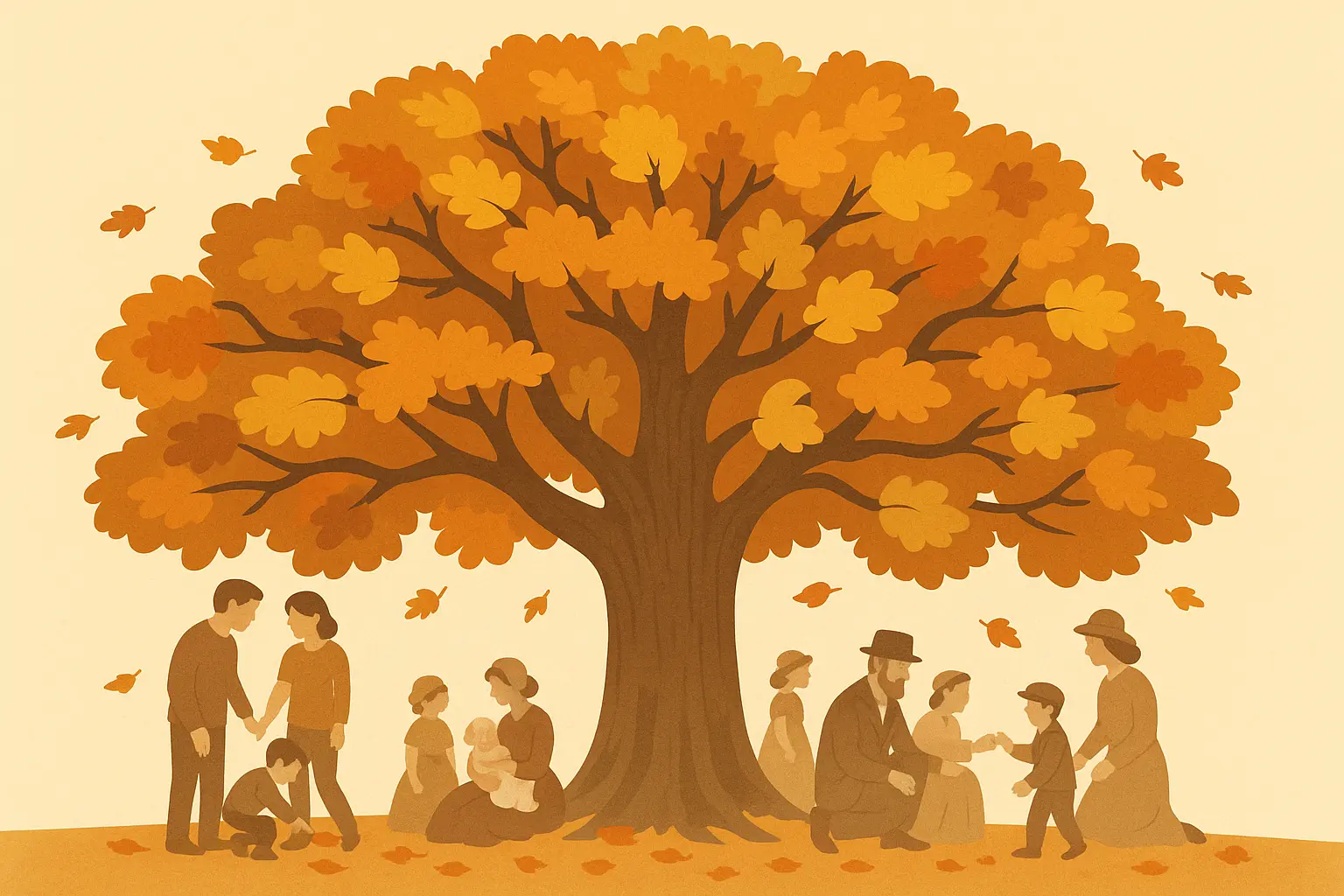
21. “Letters to Tomorrow” by Future Focused
Here’s a story that gives you an actual tradition you can steal. Family members write thanksgiving letters to their future selves, creating a practice that spans years and helps them appreciate their journey through life’s changes.
Each family member writes a letter to themselves one year in the future, sharing current gratitudes and hopes. When they read the previous year’s letters, they gain perspective on their growth and unexpected life developments. It becomes a way to track their family’s evolution and maintain connection across time.
Contemporary and Humorous Stories
22. “Thanksgiving Gone Viral” by Social Media Sam
A family’s carefully planned “Instagram-worthy” thanksgiving goes spectacularly wrong, but their honest documentation of the disaster resonates with thousands of people online. It’s a humorous look at our digital age pressures while discovering the value of authentic, imperfect moments.
When their picture-perfect thanksgiving becomes a complete mess, the family learns that authenticity connects with others more powerfully than perfection. Real gratitude doesn’t need to be performed for an audience, and sometimes the disasters make the best memories.
23. “The Vegan Turkey Rebellion” by Comedy Central
This lighthearted story tackles real family tensions when the teenage daughter announces she’s going vegan just days before thanksgiving. What starts as a battle over the turkey becomes a journey of discovery as family members learn about each other’s values.
The family initially panics about changing their traditional menu, but the process of accommodating everyone’s choices leads to creative compromise and deeper understanding. It shows how love and creativity can bridge even passionate disagreements about food choices.
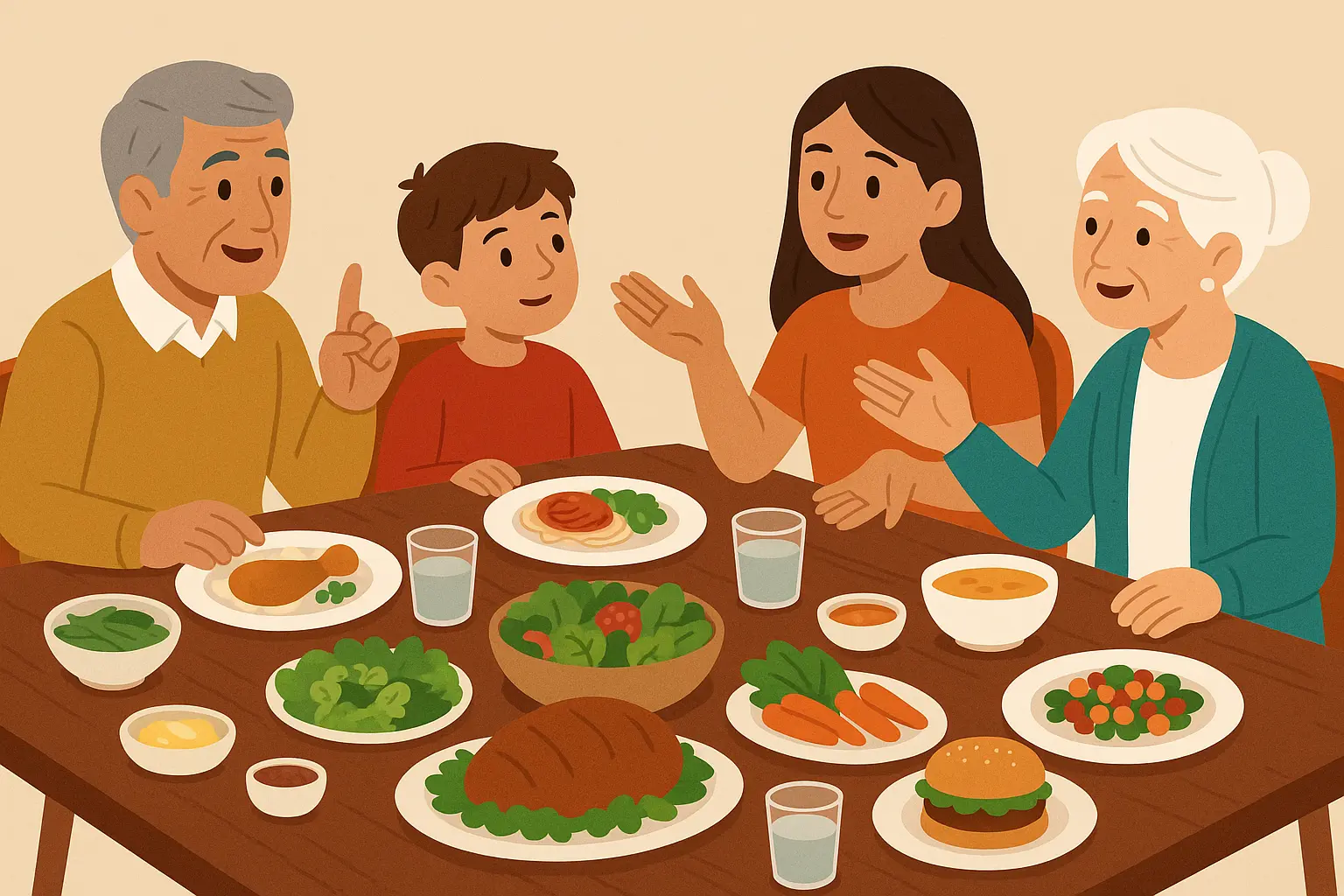
24. “Zoom Thanksgiving” by Modern Times
The extended family attempts to recreate their traditional thanksgiving dinner over video chat, complete with technical mishaps, awkward silences, and unexpected moments of connection. This timely story captures what many families experienced during recent challenging times.
Despite all the technology failures and weird moments of talking over each other, they discover that physical distance doesn’t have to diminish emotional closeness. Gratitude can be shared effectively through screens, even when everything goes wrong.
25. “The Thanksgiving Time Loop” by Sci-Fi Sarah
Someone gets stuck reliving the same disastrous family thanksgiving until they learn to appreciate their family’s quirks and express genuine gratitude. It’s like “Groundhog Day” but with cranberry sauce and family drama.
Each loop teaches the protagonist something new about their relatives and themselves, ultimately leading to genuine appreciation for their imperfect but loving family. It’s a creative twist that uses humor and fantasy to explore themes of acceptance and personal growth.
These thanksgiving short stories offer something for every reader and occasion, from quick reads during dinner to longer narratives for quiet reflection.
Here’s the real deal with picking stories:
-
Got little kids around? Stick with the family stories – they’re sweet without being too intense
-
Teaching a class? The cultural ones are perfect for getting discussions going
-
Want people laughing? Go straight to the contemporary section
-
Need a good cry? The personal growth stories will wreck you (in the best way)
-
Looking for something spiritual? The inspirational section has you covered
-
Mixed crowd with different attention spans? The community stories work for almost everyone
How to Pick Stories That Actually Work for Your Family
Let’s be honest – some thanksgiving gatherings are already stressful enough without adding deep, meaningful story time. If your family is more “pass the potatoes and let’s watch football” than “let’s explore our feelings,” maybe start with the funny ones.
Understanding how to assess thanksgiving stories against your specific situation ensures you pick narratives that will actually resonate instead of falling flat. This isn’t rocket science, but a little thought beforehand can save you from that awkward moment when everyone’s staring at their phones while you’re trying to read something meaningful.
Why “The Empty Chair” Actually Works
This beloved story works across multiple situations because it hits the sweet spot of being accessible to all ages without talking down to anyone. The themes explore grief and community service without getting overwhelming or preachy, and at roughly 1,200 words, it holds attention without dragging.
For practical use, this story works exceptionally well for family gatherings and community events where you want people to reflect on both loss and generosity without making anyone uncomfortable. It’s the kind of story that often brings listeners to tears while leaving them feeling uplifted rather than depressed.
The Community Center of Springfield has used “The Empty Chair” for three consecutive years during their public thanksgiving reading. Director Sarah Mitchell told me: “We always see people wiping away tears, but more importantly, we see strangers starting conversations afterward. Last year, two elderly attendees who had both lost spouses that year exchanged phone numbers and now have coffee weekly. That’s the power of a well-chosen story.”
When “Two Tables” Works (And When It Doesn’t)
This more sophisticated story requires careful audience consideration. It works best for mature readers who can handle complex themes about historical trauma and cultural identity. Younger audiences might struggle with the nuanced treatment of thanksgiving’s problematic history.
The thematic depth proves exceptional, addressing historical accuracy, cultural identity, and authentic gratitude despite painful history. This complexity makes it valuable for educational settings but potentially challenging for casual family reading where people just want to feel good.
This story excels in educational settings and cultural discussions but might not suit traditional family gatherings seeking lighter content. Know your crowd before diving into this one.
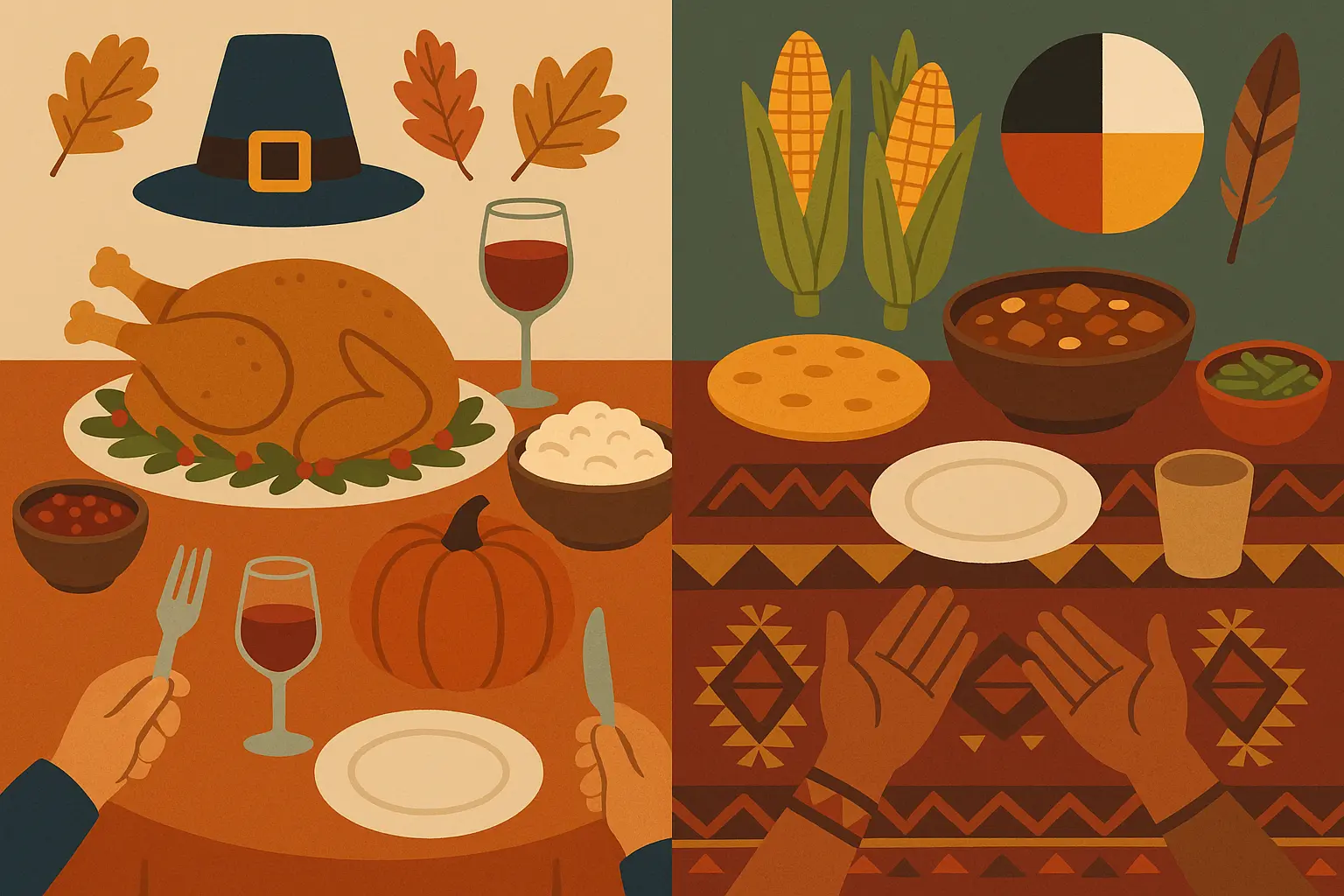
What Works with Contemporary Humor
“Thanksgiving Gone Viral” appeals strongly to social media-savvy audiences while addressing modern issues of authenticity versus performance. The contemporary format with humor keeps readers engaged without sacrificing meaningful messages about connection and authenticity.
For practical application, it works excellently with younger audiences and discussions about digital literacy and authentic living. If your family includes teenagers who live on their phones, this might be your entry point.
|
Real Talk Evaluation |
“The Empty Chair” |
“Two Tables” |
“Thanksgiving Gone Viral” |
|---|---|---|---|
|
Who It Actually Works For |
Pretty much everyone |
Mature readers who can handle heavy topics |
Teens/Adults who get social media |
|
Will Anyone Be Offended? |
Probably not |
Possibly, if they’re sensitive about history |
Only if they hate technology |
|
Emotional Impact |
Tears and hope |
Deep thoughts and education |
Laughter with some heart |
|
Best Used For |
Family/Community events |
Educational settings |
Youth discussions |
|
Difficulty Level |
Easy for everyone |
Requires some thinking |
Easy but relevant |
Want to Write Your Own? Here’s How AI Can Help
Look, if none of these stories fit your family’s weird traditions (and every family has weird traditions), you can actually create your own. I know, I know – “I’m not a writer!” But these AI tools make it surprisingly easy. You just tell it about your family’s quirks, and it helps you turn them into an actual story.
Modern AI story generators offer powerful tools for creating personalized thanksgiving stories that reflect your unique experiences and traditions. Whether you’re looking to document family history, create new traditions, or simply explore your relationship with gratitude through storytelling, AI can help transform your ideas into compelling narratives.
Getting Past the Blank Page Problem
Starting a thanksgiving story often feels impossible when you’re staring at nothing. Nairrate’s story starters generator provides compelling opening lines specifically for thanksgiving themes – from mysterious family secrets revealed during dinner to heartwarming tales of unexpected guests showing up at just the right moment.
The AI understands how stories should flow and can suggest character motivations and interactions that actually make sense. Whether you’re writing about your multigenerational family chaos or a community thanksgiving celebration, the character story generator helps you develop characters that feel real instead of cardboard cutouts.
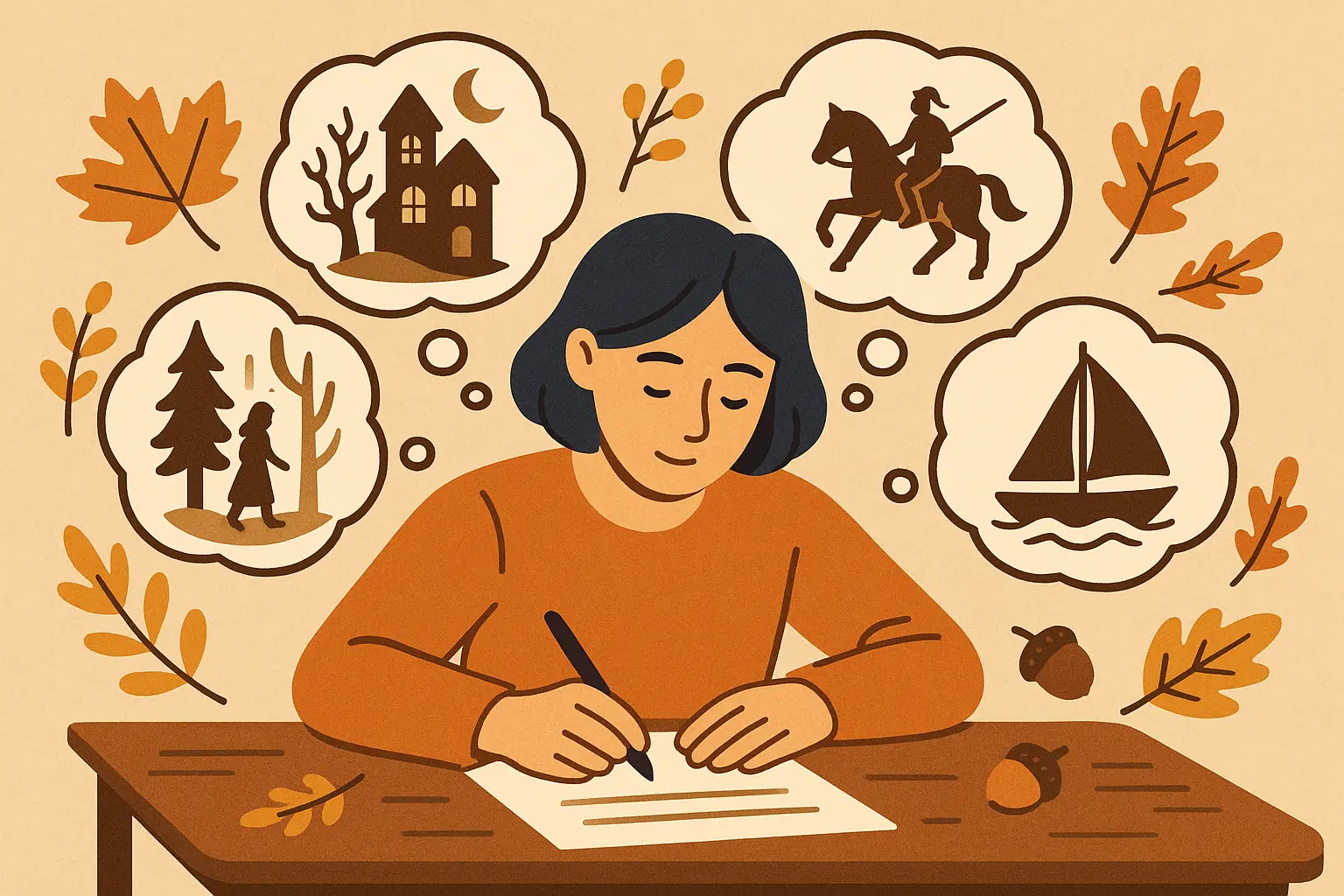
Exploring Different Perspectives
Just like our curated list includes various cultural viewpoints, AI can help you explore thanksgiving stories from angles you might not have considered. You could write from the perspective of a recent immigrant experiencing their first American thanksgiving, a military family separated by deployment, or a community coming together after experiencing hardship.
The AI helps with research and cultural awareness while encouraging you to seek additional input when representing experiences outside your own background. This approach helps create respectful, accurate portrayals that honor different traditions without being tokenistic.
Making It Actually Good
Whether you want to craft a heartwarming family story, a humorous thanksgiving disaster tale, or a reflective piece about gratitude during difficult times, AI understands what makes each type of thanksgiving story work.
The technology recognizes that thanksgiving stories need particular emotional beats – the gathering, the reflection, the gratitude revelation, and the deeper connection. It helps maintain these essential elements while exploring your unique angle and personal experiences.
Making It Personal
Input your family’s actual traditions, cultural background, or specific thanksgiving experiences, and AI will help you craft narratives that honor your personal story while creating something others can relate to. The story theme generator can suggest ways to weave in family recipes, traditional sayings, or cultural practices that make your story authentically yours.
From initial idea to finished story, AI provides creative suggestions that push you to explore new possibilities while keeping the warmth and meaning essential to thanksgiving storytelling. You can develop stories that become part of your family’s annual reading tradition or contribute to community collections.

Final Thoughts
Here’s what I’ve learned after years of story-hunting: the best thanksgiving story is the one that makes your family stop scrolling their phones and actually look at each other. Whether that’s a tear-jerker about empty chairs or a ridiculous tale about vegan turkey drama, pick the one that fits YOUR people.
These 25 thanksgiving stories represent the full spectrum of human experience during one of our most cherished holidays. From traditional family narratives that’ll make your grandma happy to contemporary tales addressing modern chaos, each story offers unique insights into gratitude, connection, and how celebration keeps evolving.
The evaluation approach we’ve explored – knowing your audience, understanding what themes will resonate, being realistic about cultural sensitivity, considering emotional impact, and thinking about practical application – gives you a framework for selecting stories that will actually create meaningful experiences instead of awkward silences.
Remember that the most powerful thanksgiving stories often challenge us to expand our understanding of gratitude beyond simple thankfulness for material stuff. The best narratives explore complex themes like forgiveness, cultural identity, personal growth, and community building while remaining accessible and emotionally engaging.
Will reading a story magically fix your family’s dysfunction? Probably not. Will it give you something to talk about besides politics and who’s dating whom? Absolutely. Sometimes that’s enough.
As you consider incorporating these stories into your thanksgiving traditions, think about how they might spark conversations, create new family customs, or deepen your appreciation for the diverse ways people experience this holiday. The stories we share shape our understanding of what thanksgiving means and help pass those values to future generations.
And if it flops? Well, at least you’ll have a funny story about the time you tried to make thanksgiving more meaningful and everyone just wanted to eat pie.



Add comment